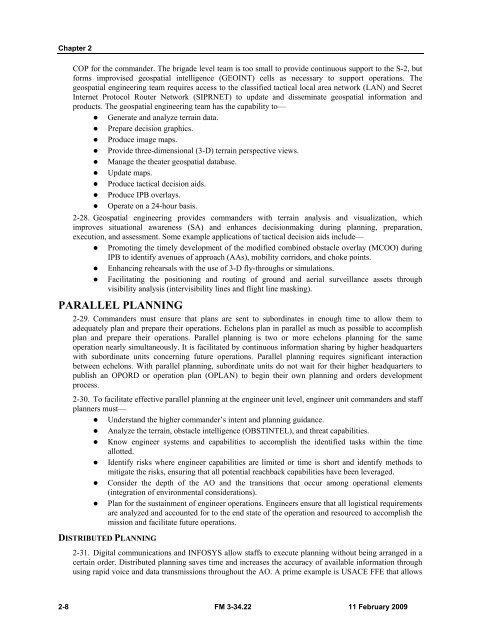FM 3-34.22 - Army Electronic Publications & Forms - U.S. Army
FM 3-34.22 - Army Electronic Publications & Forms - U.S. Army
FM 3-34.22 - Army Electronic Publications & Forms - U.S. Army
Create successful ePaper yourself
Turn your PDF publications into a flip-book with our unique Google optimized e-Paper software.
Chapter 2<br />
COP for the commander. The brigade level team is too small to provide continuous support to the S-2, but<br />
forms improvised geospatial intelligence (GEOINT) cells as necessary to support operations. The<br />
geospatial engineering team requires access to the classified tactical local area network (LAN) and Secret<br />
Internet Protocol Router Network (SIPRNET) to update and disseminate geospatial information and<br />
products. The geospatial engineering team has the capability to—<br />
� Generate and analyze terrain data.<br />
� Prepare decision graphics.<br />
� Produce image maps.<br />
� Provide three-dimensional (3-D) terrain perspective views.<br />
� Manage the theater geospatial database.<br />
� Update maps.<br />
� Produce tactical decision aids.<br />
� Produce IPB overlays.<br />
� Operate on a 24-hour basis.<br />
2-28. Geospatial engineering provides commanders with terrain analysis and visualization, which<br />
improves situational awareness (SA) and enhances decisionmaking during planning, preparation,<br />
execution, and assessment. Some example applications of tactical decision aids include—<br />
� Promoting the timely development of the modified combined obstacle overlay (MCOO) during<br />
IPB to identify avenues of approach (AAs), mobility corridors, and choke points.<br />
� Enhancing rehearsals with the use of 3-D fly-throughs or simulations.<br />
� Facilitating the positioning and routing of ground and aerial surveillance assets through<br />
visibility analysis (intervisibility lines and flight line masking).<br />
PARALLEL PLANNING<br />
2-29. Commanders must ensure that plans are sent to subordinates in enough time to allow them to<br />
adequately plan and prepare their operations. Echelons plan in parallel as much as possible to accomplish<br />
plan and prepare their operations. Parallel planning is two or more echelons planning for the same<br />
operation nearly simultaneously. It is facilitated by continuous information sharing by higher headquarters<br />
with subordinate units concerning future operations. Parallel planning requires significant interaction<br />
between echelons. With parallel planning, subordinate units do not wait for their higher headquarters to<br />
publish an OPORD or operation plan (OPLAN) to begin their own planning and orders development<br />
process.<br />
2-30. To facilitate effective parallel planning at the engineer unit level, engineer unit commanders and staff<br />
planners must—<br />
� Understand the higher commander’s intent and planning guidance.<br />
� Analyze the terrain, obstacle intelligence (OBSTINTEL), and threat capabilities.<br />
� Know engineer systems and capabilities to accomplish the identified tasks within the time<br />
allotted.<br />
� Identify risks where engineer capabilities are limited or time is short and identify methods to<br />
mitigate the risks, ensuring that all potential reachback capabilities have been leveraged.<br />
� Consider the depth of the AO and the transitions that occur among operational elements<br />
(integration of environmental considerations).<br />
� Plan for the sustainment of engineer operations. Engineers ensure that all logistical requirements<br />
are analyzed and accounted for to the end state of the operation and resourced to accomplish the<br />
mission and facilitate future operations.<br />
DISTRIBUTED PLANNING<br />
2-31. Digital communications and INFOSYS allow staffs to execute planning without being arranged in a<br />
certain order. Distributed planning saves time and increases the accuracy of available information through<br />
using rapid voice and data transmissions throughout the AO. A prime example is USACE FFE that allows<br />
2-8 <strong>FM</strong> 3-<strong>34.22</strong> 11 February 2009

















